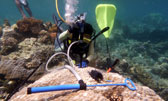




_160916_006.jpg) Dr Erik Velasco, SMART CENSAM research scientist, with portable scientific instruments at VivoCity bus stop
Dr Erik Velasco, SMART CENSAM research scientist, with portable scientific instruments at VivoCity bus stop
1. Singapore – Approximately 63% of Singapore’s population commute to work by bus every day. Just how much pollution are we breathing while we’re waiting at the bus stops? Dr Erik Velasco, the air pollution expert at the Singapore-MIT Alliance for Research and Technology (SMART) [新加坡-麻省理工学院科研中心], and a former NUS student Ms Tan Sok Huang took measurements of different air pollution parameters at busy bus stops in Singapore. They found that:
a. Exposure concentration of PM2.5 was on average 1.5-3 times higher than the mean concentration at ambient level reported by local authorities.
b. The pollution levels can be highly variable. At least one spike over 100 µg/m3 can be expected every 5 min. The magnitude of these spikes is similar to that reported during heavy events of haze. Using NEA’s new PM2.5 bandings, these spikes will rate as high or very high.
c. On average, 60% of these particles are composed of soot. The rest is a mix of inorganic and organic compounds, in addition to particles with heavy metals. All of them are highly toxic.
d. The observed levels of particles are higher than those reported in bus stops of Canada and United States and similar to those along streets and bus stops of Hong Kong and Mexico City.
e. There is growing scientific evidence that very short (less than one hour) exposure to traffic particles exacerbates existing pulmonary and cardiovascular diseases.
f. The size of the ultrafine particles is estimated to be 27 nanometers, i.e. 100 times smaller than PM2.5.
2. These findings were published in the paper, ‘Particles exposure while sitting at bus stops of hot and humid Singapore’ in Atmospheric Environment in August 2016. The researchers sought to quantify pollution in-situ at five bus stops in Singapore.
See news release/factsheet and youtube for more.
The story was also published in Singapore newspapers, including MyPaper.